Elementary Linear Algebra [5 ed.] 0471848190, 9780471848196
1,013 85 48MB
English Pages [568] Year 1987
Polecaj historie
Citation preview
Howard Anton
Elenwntar]/ Linear Algebra Se
?-
ELEMENTARY LINEAR ALGEBRA EDITION FIFTH
HOWARD ANTON Drexel University
JOHN WILEY & SONS New York
•
Chichester Brisbane Toronto Singapore •
•
•
Copyright
©
1973, 1977, 1981, 1984,
All rights reserved.
and 1987, by Anton Textbooks,
Published simultaneously
in
Canada.
Reproduction or translation of any part of this
work beyond
that permitted by Sections
107 and 108 of the 1976 United States Copyright
Act without the permission of the copyright owner is unlawful. Requests for permission or further information should be addressed to the Permissions Department,
John Wiley
&
Sons.
Library of Congress Cataloging in Publication Data
Anton, Howard.
Elementary linear algebra. Includes index. 1.
Algebra, Linear.
QA184.A57
ISBN
1987
I.
Title.
512'.5
0-471-84819-0
Printed in the United States of America
10
9
8
7
86-11087
Inc.
To Pat and
my
Brian, David,
children:
and Lauren
Digitized by the Internet Archive in
2010
http://www.archive.org/details/elementarylinearOOanto
Preface
This textbook provides an elementary treatment of linear algebra that is suitable for students in their freshman or sophomore year. Calculus is not a prerequisite. I have, however, included a number of exercises for students with a calculus background; these are clearly marked: "For students who have studied calculus." My aim in writing this book is to present the fundamentals of hnear algebra in the clearest possible way. Pedagogy is the main consideration; formalism is
secondary. Where possible, basic ideas are studied by means of computational examples (over 200 of them) and geometrical interpretation. My treatment of proofs varies. Those proofs that are elementary and have significant pedagogical content are presented precisely, in a style tailored for be-
A few
more difficult, but pedagogically valuable, are placed at the ends of the sections and marked "Optional." Still other proofs are omitted completely, with emphasis placed on applying the theorem. Whenever a proof is ginners.
omitted,
I
proofs that are
try to
motivate the
result, often
with a discussion about
its
interpretation
in 2-space or 3-space. It is
my
experience that Z-notation
is
more
of a hindrance than a help for
have generally avoided its use. should proceed from the familiar to teacher pedagogical axiom that a It is a The ordering of the chapters the abstract. from the concrete to unfamiliar and the adherence to this tenet. reflects my
beginners in linear algebra. Therefore,
Chapter
1
I
deals with systems of linear equations,
of their properties.
It
how
also contains the basic material
to solve them,
on matrices and
and some
their arith-
metic properties.
have used the classical permutation than the approach through n-linear alternating forms, gives the student a better intuitive grasp of the subject than an Chapter 2 introduces determinants.
approach. In
my
opinion,
it
is
I
less abstract
vi
I
Preface
inductive development,
vanced topics
and provides the best foundation
for a future study of ad-
in linear algebra.
Chapter 3 introduces vectors in 2-space and 3-space as arrows and develops the analytic geometry of lines
and planes
in 3-space.
Depending on the background
of the students, this chapter can be omitted without a loss of continuity (see the
guide for the instructor that follows this preface).
Chapter 4 and Chapter 5 develop the basic results about real finite-dimenand linear transformations. I begin with a study of /?" and
sional vector spaces
proceed slowly to the general concept of a vector.
Chapter 6 deals with the eigenvalue problem and diagonalization. Chapter 7 gives some applications of linear algebra to problems of approximasystems of differential equations, Fourier series, and identifying conic sections and quadric surfaces. Applications to business, biology, engineering, economics, the social sciences, and the physical sciences are included in an optional paperback tion,
supplement to this text. Applications of Linear Algebra, by Chris Rorres and the author. Included in the supplement are such topics as curves of best fit to empirical data, population dynamics, Markov processes, optimal harvesting, Leontief models in economics, engineering applications, graph theory, and an introduction to linear programming. There is also an alternate version of this text, called Elementary Linear Algebra with Applications, that combines material in Applications of Linear Algebra.
this text
and most of the
Chapter 8 introduces numerical methods of linear algebra; it does not require computing facilities since the exercises can be solved by hand computa-
access to
tion or with the use of a pocket calculator. This chapter gives the student a basic
understanding of
many
how
certain linear algebra problems are solved practically.
Too
students complete their linear algebra studies with the naive belief that
ei-
Some inLIN EAR-KIT'^^
genvalues are found in practice by solving the characteristic equation. structors
may
wish to use
software package that
is
this section in
conjunction with the
available as a supplement to this text.
Chapter 9 gives a brief introduction to complex numbers and then proceeds development of complex vector spaces and inner product spaces. Unitary,
to the
Hermitian, and normal matrices are studied, and the chapter concludes with the
proof that symmetric matrices have real eigenvalues.
I
have included a large number of exercises. Each exercise set begins with drill problems and progresses towards more theoretical problems. Answers the computational problems are given at the end of the text.
routine to all
Preface
Since there
is
more material in
this
or one-quarter course, the instructor help in this selection,
I
/
vii
book than can be covered
will
in a one-semester have to make a selection of topics. To
have provided a guide to the instructor following
this
preface.
NEW FEATURES
IN
The wide acceptance of grateful for the
from •
users. In
many
THE FIFTH EDITION the
first
favorable
four editions has been most gratifying and
comments and
response to these suggestions
I
I
am
constructive suggestions received
have made the following changes:
During the 14 years that have passed since this text was first pubhshed, the widespread use of computers has significantly increased the importance of numerical methods in linear algebra. In recognition of this I have rewritten Chapter 8, which deals with this topic. There is a new section on LU-decompositions and a new section in which the various methods for solving linear systems are compared in terms of the number of operations they require. The inverse power method for finding "smallest" eigenvalues has been introduced, and the student is given more information on the advantages and disadvantages of various numerical methods. However, this chapter is still intended only as a brief introduction to the topic.
•
The Supplementary
Exercises have been greatly expanded to provide a richer
variety of problems. •
Examples have been added and exposition improved
•
To
in
many parts
of the text.
reduce the level of abstraction, the material on length and angle
in
inner
product spaces has been rewritten, and more examples of inner products have been added. •
As a general rule, I prefer to explain concepts in words rather than symbols. However, so many readers asked that I introduce the notation [Tjg for the matrix of a Hnear operator with respect to a basis B and [TJ^ ^ for the matrix of a linear transformation with respect to bases B and B' that I have done so.
•
New
material on positive definite matrices and quadratic forms has been
added.
SUPPLEMENTARY MATERIALS Manual for Elementary Linear Algebra by Elizabeth M. Grobe and Charles A. Grobe, Jr. contains detailed solutions to most theoret-
• Student Solutions
ical exercises
and many computational
exercises.
via
Preface
I
• Applications of Linear
Algebra by Chris Rorres and
Howard Anton
contains
applications to business, biology, engineering, economics, the social sciences,
and the physical sciences. This supplement also contains a "minicourse" linear programming which can be covered in about six lectures. • Solutions
Manual for Applications of Linear Algebra contains
in
detailed solu-
tions to all exercises. •
Elementary Linear Algebra with Applications by Rorres
is
an expanded version of
Howard Anton and
this text that includes
Chris
most of the material
from Applications of Linear Algebra. •
LINEAR-KIT^^ — A new most of the basic mals.
Apple •
It is
lie.
Hnear algebra software package that can perform
linear algebra
available for
IBM
lie,
and the
This software requires 128K of memory.
LINEAR-KIT^^ LINEAR-KIT'^^
—
A book of linear algebra problems LIN EAR-KIT'^^ software package.
Problem Book
signed to be solved using the •
computations using either fractions or deci-
compatible computers, the Apple
Applications Problem
Book
— A book of
plications problems designed to be solved using the
ware package. Intended
de-
linear algebra ap-
LINEAR-KIT'^
soft-
use with Applications of Linear Algebra or Elementary Linear Algebra with Applications.
If
any of these supplements
is
for
not in stock, ask your bookstore manager to order
a copy for you.
HOWARD ANTON
A Guide for the Instructor
STANDARD COURSE Chapter
3
can be omitted without loss of continuity
if
the students have previ-
and geometric vectors in 2-space and 3-space. Depending on the available time and the background of the students, the instructor may wish to add all or part of this chapter to the following suggested core material: ously studied
lines, planes,
Chapter 1 Chapter 2 Chapter 4 Chapter 5 Chapter 6
7 lectures 5 lectures
14 lectures 6 lectures 5 lectures
This schedule
is
rather liberal;
it
allows a
fair
discussion of homework problems but assumes that to the material
marked
"optional."
The
amount little
instructor can build
permits by including lectures on optional material, Chapter 8,
and Chapter
of classroom time for
classroom time
3,
on
this
is
devoted
core as time
Chapter
7,
Chapter
9.
APPLICATIONS-ORIENTED COURSE Instructors
who want
to
emphasize applications or numerical methods
the following program, which reaches eigenvalues
Chapter 1 Chapter 2
7 lectures
Sections 4.1-4.6
8 lectures
Sections 5.1-5.2
3 lectures
Sections 6.1-6.2
3 lectures
may
and eigenvectors more
prefer
quickly:
5 lectures
IX
X
I
A Guide for
the Instructor
Whenever Sections
5.4
material at the end of nalization problem,
Once Chapter
7,
and 6.1,
and
5.5 are deleted, the instructor
delete
the above material
Chapter
8,
should omit the optional
begin Section 6.2 with the matrix form of the diago-
Example 9 is
in that section.
covered, the instructor can choose topics from
or Chapter 9 in the text or else choose topics from the
supplement, Applications of Linear Algebra. Depending on which topics are selected, it may be necessary to cover some of the material in Sections 4.7-4.10 or 5.3-5.5.
COMPUTER-ORIENTED COURSE Either the standard course or the application-oriented course can be taught in con-
junction with the
LINEAR-KIT^^ software together with the LINEAR-KIT^^ LINEAR-KIT^^ Applications Problem Book to supplement
Problem Book or the the exercises.
will
Because problems can be solved so quickly using LINEAR-KIT'^, students much less time to solve homework problems, which should allow them
need
to cover
more material or
the
same material
in
more depth.
A ckno wiedgments
I
express
my
appreciation for the helpful guidance provided by the following
people:
Joseph Buckley, Western Michigan University Harold S. Engelsohn, Kingsborough Community College Lawrence D. Kugler, University of Michigan
Robert W. Negus, Rio Hondo Junior College Hal G. Moore, Brigham Young University William A. Brown, University of Maine at Portland-Gorham Ralph P. Grimaldi, Rose-Hulman Institute of Technology Robert M. McConnel, University of Tennessee James R. Wall, Auburn University Roger H. Marty, Cleveland State University Donald R. Sherbert, University of Illinois Joseph L. Ullman, University of Michigan Arthur G. Wasserman, University of Michigan J. Hightower, University of Colorado Marjorie E. Fitting, San Jose State University
Collin
Bruce Edwards, University of Florida Garret Etgen, University of Houston
Donald P. Minassian, Butler University David E. Flesner, Gettysburg College Arlene Kleinstein Bart
S.
Ng, Purdue University
Mathew Gould, C.
S.
Ballantine,
Vanderbilt University
Oregon State University
Douglas McLeod, Drexel University Craig Miller, University of Pennsylvania William Scott, University of Utah F. P. J. Rimrott, University of Toronto
xii
I
Acknowledgments I
am
also
grateful
to
William
F.
Trench of Trinity University, whose
suggestions immeasurably improved both the style and content of the text and
Steven C. Althoen of the University of Michigan-Flint trary to is
pointed out that, con-
named
statement in previous editions, the Gauss-Jordan reduction procedure after the German engineer Wilhelm Jordan and not the famous mathe-
matician, Camille Jordan.
work
who
my
due to Dale Lick who encouraged my Corey who helped make the first edition Gary W. Ostedt, who guided this book through
Thanks are
also
in its early stages, to Frederick C.
a reahty, and to
my
former editor,
three successful editions. Finally,
I
am
Wiley and especially to my editor, the development of this new edition.
indebted to the entire production staff of
Robert
Pirtle, for his
invaluable help during
H. A.
Contents
Chapter One SYSTEMS OF LINEAR EQUATIONS AND MATRICES 1.1
1.2
1.3 1.4 1.5 1.6 1.7
Introduction to Systems of Linear Equations 1 Gaussian Elimination 8 Homogeneous Systems of Linear Equations 19 Matrices and Matrix Operations 23 Rules of Matrix Arithmetic 31 Elementary Matrices and a Method for Finding A~^ 43 Further Results on Systems of Equations and Invertibility
Chapter
57
Two
DETERMINANTS 2.1
1
65
The Determinant Function
65
12 Evaluating Determinants by Row Reduction Determinant Function lA Cofactor Expansion; Cramer's Rule 84
2.3 Properties of the
72
78
\\
Chapter Three
VECTORS IN 2-SPACE AND 3-SPACE
99
3.1
Introduction to Vectors (Geometric)
3.2
Norm
3.3
Dot Product; Projections
3.4
Cross Product
3.5 Lines
of a Vector; Vector Arithmetic
99 109
112
122
and Planes
in 3-space
130
Xlll
xiv
I
Contents
Chapter Four VECTOR SPACES 143 143
4.1
Euclidean n-Space
4.2
General Vector Spaces
4.3 4.4
Subspaces 755 Linear Independence
164
4.5
Basis and Dimension
171
4.6
Row and Column
4.7
Inner Product Spaces
150
Space; Rank; Finding Bases
779
797
Length and Angle in Inner Product Spaces 198 Orthonormal Bases; Gram-Schmidt Process 209 227 4.10 Coordinates; Change of Basis 4.8 4.9
I"
Chapter Five LINEAR TRANSFORMATIONS 5.1
245
Introduction to Linear Transformations
5.2 Properties of Linear Transformations; 5.3
5.4
254
Linear Transformations from R" to R!"; Geometry of Linear Transformations from R^ to R^ 263 Matrices of Linear Transformations 280
5.5 Similarity
290
Chapter Six EIGENVALUES, EIGENVECTORS 6.1
245
Kernel and Range
Eigenvalues and Eigenvectors
6.2 Diagonalization
301
301
309
v\6.3 Orthogonal Diagonalization; Symmetric Matrices
318
Chapter Seven APPLICATIONS* 329 329 Approximation Problems; Fourier Series 13 Quadratic Forms 342 lA Diagonalizing Quadratic Forms; Application to Conic
7.1
Application to Differential Equations
7.2 Application to
Sections
335
i57
7.5 Application to
Quadric Surfaces
364
/^ *
Additional applications to business, economics, and the physical and social sciences are available in
the supplement to this text. Applications of Linear Algebra or in the
Linear Algebra with Applications.
expanded version of this
text.
Elementary
Contents
Chapter Eight
INTRODUCTION TO NUMERICAL METHODS OF LINEAR ALGEBRA 371 8.1
Comparison of Procedures
8.2
LL/-Decompositions
8.3
The Gauss-Seidel and Jacobi Methods 391 Reduction of Roundoff Error 398 Approximating Eigenvalues by the Power Method 404 Approximating Nondominant Eigenvalues; Deflation and Inverse Power Methods 413
for Solving Linear
Systems
8.4 Partial Pivoting; 8.5
8.6 ,
./
Chapter Nine
COMPLEX VECTOR SPACES 9.1
9.2
9.3 9.4 9.5
Normal, and Hermitian Matrices
^\ ANSWERS TO EXERCISES INDEX
421
Complex Numbers 421 Modulus; Complex Conjugate; Division 429 Polar Form; DeMoivre's Theorem 437 Complex Vector Spaces 447 Complex Inner Product Spaces 454
9.6 Unitary,
II
371
382
Al
463
j
xv
CHAPTER ONE
Systems of Linear Equations and Matrices
1 .1
INTRODUCTION TO SYSTEMS OF LINEAR EQUATIONS In this section
we introduce
and discuss a method
basic terminology
for solving
systems of linear equations.
A
line in the xj'-plane
can be represented algebraically by an equation of the
form
An
equation of this kind
we
generally,
is
called a linear equation in the variables
define a linear equation in the n variables x^, X2,
that can be expressed in the
Example
,a„
,
y.
More
x„ to be one
form
a 1X1
where 0^,02,
x and
and b are
+
a 2X2
+
•
•
+
•
a„x„
=
b
real constants.
1
The following
are linear equations .V
_v
+ 3v = 7 = ix + 3z +
-
Xi 1
xi
-
2x2
+
X2
3x3
+
•
•
+ X4 = + x„ =
7 1
any products or roots of variables. power and do not appear as arguments for trigonometric, logarithmic, or exponential functions. The following are not linear
Observe that a
linear equation does not involve
All variables occur only to the first
equations:
+ 3.V- = — sin X =
X y
7
3x
+
^ x^
2_v
+
-
z
2x2
+ +
xz -^'3
= =
4 1
2
Systems of Linear Equations and Matrices
I
A Xi
=
,
s„
+ QjXj + such that the equation is
x„
=
s„.
solution of a linear equation AjXi
of « numbers Si,S2, Si,
Xj
=
S2,
.
.
.
.
,
.
.
The
of
set
•
•
+
a„x„
=
ft
solutions of the equation
all
a sequence
is
when we
satisfied
substitute
is
called
its
solution set.
Example 2 Find the solution (i)
set
-2y=\
Ax
To
of each of the following:
(ii)
-
x^
find solutions of
(i),
+
Axj
we can
7x3
=
5
assign an arbitrary value to x
or choose an arbitrary value for y and solve for and assign x an arbitrary value t, we obtain
X
=
x. If
we
and solve for >', first approach
follow the
y^2t-^
f,
These formulas describe the solution set in terms of the arbitrary parameter t. Particular numerical solutions can be obtained by substituting specific values for t. For example, t — 3 yields the solution x = 3, 3/ = 11/2 and t = —Ijl yields the solution X If
we
= —\l2,y— — 3/2. follow the second approach and assign y the arbitrary value •X
Although these formulas are
=
if
+
y
i,
=
f,
we obtain
t
from those obtained above, they yield the For example, the previous formulas gave the solution x = 3, 3; = 11/2 when t = 3, while these
same solution
set as
t
formulas yield this solution
To
different
varies over all possible real numbers.
when
=
t
11/2.
we can
assign arbitrary values to any two and solve for the third variable. In particular, if we assign arbitrary values to X2 and X3, respectively, and solve for Xj, we obtain find the solution set of
(ii)
variables s
and
t
Xj
=
5
+
—
4s
X2
7f,
=
A finite set of linear equations in the variables x^-, of
linear equations or a linear system.
called a solution of the system
x^
if
=
A
X3
s,
X2,
= .
.
t
.
,
x„
is
sequence of numbers
5^,
X2
=
^2
^n
=
^n
called a system
^i, ^2 is
5„ is
a solution of
every equation in the system. For example, the system
4Xi 3xi
has the solution Xj
However, x^ the
first
=
1,
= X2
1,X2
=
8,
-X2 + 3X3= -1 + X2 + 9x3 = -4
=
2,
X3
X3
=
1
= —1
is
since these values satisfy
both equations.
not a solution since these values satisfy only
of the two equations in the system.
Introduction to Systems of Linear Equations
/./
Not
all
systems of linear equations have solutions. For example,
/
3
we multiply
if
the second equation of the system
x+
V
+
2y
2.\-
by
1/2,
it
becomes evident
that there are .V
X
= =
4 6
no solutions since the resulting system
+y= +y=
4 3
has contradictory equations.
A is
system of equations that has no solutions
at least
can occur
one solution, in
is
it
called consistent.
is
To
said to be inconsistent.
If
there
illustrate the possibilities that
solving systems of linear equations, consider a general system of two
hnear equations
in the
unknowns
flj-v
ih.y
+ ^1 r = + h^y =
.y
and
v:
t'l
{a^.b^ both not zero)
c'2
(cij.hn
both not zero)
The graphs of these equations are lines; call them /j and l2- Since a lies on a line if and only if the numbers x and y satisfy the equation
point {x,y) of the
line,
the solutions of the system of equations will correspond to points of intersection of (a)
/i
and
Ij.
the lines
There are three /j
and
Ij
may
possibilitiees (Figure
1.1):
be parallel, in which case there
is
no intersection and
consequently no solution to the system; (b) the lines
and
/^
/,
may
intersect at only
one point,
in
which case the system
has exactly one solution; (c)
the lines
/j
and
I2
may
coincide, in which case there are infinitely
of intersection and consequently infinitely
many
/j
Ay
(c)
Figure 1.1 (a)
No
solution, (b)
One
solution, (c) Infinitely
many
points
solutions to the system.
many
solutions.
y
and
1
4
I
Systems of Linear Equations and Matrices
Although we have considered only two equations with two unknowns show later that this same result holds for arbitrary systems; that is,
here,
we
will
every system of linear equations has either no solutions, exactly one solution, or infinitely
An
many
solutions.
arbitrary system of
m
«ll-^l
«21-^1
where
x^, Xj,
.
.
.
,
+ +
+ +
^12-^2 «22-^2
•
•
•
•
•
•
+ +
unknowns and
x„ are the
unknowns
linear equations in n
dln^r,
a2„X„
= =
be written
will
^1
bj
the subscripted a's
and
6's
denote
constants.
For example, a general system of three
linear equations in four
unknowns
will
be written
«21^1
+ +
«22^2
«31^'l
+
«32'^2
«ll-^l
^12^2
The double subscripting on the that
is
on the
+ + +
«23-^3
«33^3
«14-^4
«24'^4 «34-^4
coefficients of the
= = =
^1
^2 ^3
unknowns
is
a useful device
used to specify the location of the coefficient in the system. The coefficient a,^ indicates the
equation and multiplies
we mentally keep
first
subscript
equation in which the coefficient occurs, and the
second subscript indicates which unknown If
+ + +
«13-^3
unknown
it
multiplies. Thus, a ^2
is
in the first
X2.
track of the location of the
+ 's,
the x's,
and the
= 's,
a
system of m linear equations in n unknowns can be abbreviated by writing only the rectangular array of numbers: flu
fll2
fliIn
b:
fl,,
a-,-,
a-2n
b2
b,n_
'mil
is called the augmented matrix for the system. (The term matrix is used in mathematics to denote a rectangular array of numbers. Matrices arise in many contexts; we shall study them in more detail in later sections.) For example, the augmented matrix for the system of equations
This
Xi
2xi 3xi
+ + +
X2
4x2 6x2
+ -
2x3 3x3 5x3
= = =
9 1
IS
'1
1
2
4
3
6
2
-3 -5
9" 1
1. 1
Introduction to Systems of Linear Equations
/
5
REMARK. When constructing an augmented matrix, the unknowns must be written same order in each equation.
in the
The
method for solving a system of Hnear equations is to replace the new system that has the same solution set but which is easier to solve. This new system is generally obtained in a series of steps by applying the following three types of operations to eliminate unknowns systematically. basic
given system by a
1.
Multiply an equation through by a nonzero constant.
2.
Interchange two equations.
3.
Add
a multiple of one equation to another.
Since the rows (horizontal Hnes) of an augmented matrix correspond to the
equations in the associated system, these three operations correspond to the following operations on the rows of the augmented matrix.
These are called elementary row operations. The following example illustrates these operations can be used to solve systems of linear equations. Since a systematic procedure for finding solutions will be derived in the next section, it is not necessary to worry about how the steps in this example were selected. The main effort at this time should be devoted to understanding the computations
how
and the
discussion.
Example 3 In the
left
column below we solve
on the same system by
a system of linear equations by operating
equations in the system, and in the right column
we
solve the
operating on the rows of the augmented matrix.
X
2x 3x
Add —2
+ + +
>•
4v 6v
+ -
times the
2z 3z 5r
= = =
first
9
1
1
1
2
4
3
6
equation to
the second to obtain
9 + 2r= 2.V- lz= -17 + 6v - 5r =
.\'+
3.Y
y
Add —2
2
-3 -5
times the
first
9 1
row
second to obtain 1
1
2 3
6
2
9
-7 -5
-17
to the
6
Systems of Linear Equations and Matrices
I
Add (—3
times the
first
Add —3
equatioiy to
the third to obtain
X
+
times the
row
first
to the
third to obtain "1
+ 2z= 9 2y- lz= -11 ^y- llz= -27 y
9"
2
1
2
-7
3
-11
-17 -27
Multiply the second equation by 1/2
Multiply the second row by 1/2 to
to obtain
obtain
+
X
y
+
y-
7
z
3>'- llz
Add
'1
Iz
= =
-V
i
2
27
3
-11
Add — 3
second equation/to
f- 3 times the
the third to obtain
X
+
+
2
-27
times the second
row
2z
'1
9 17 2 3 2
1
2
1
^
^
9"
^
-i2
-^2_
Multiply the third equation by
Multiply the third row by
to obtain
obtain
X
+
= 9 17 = y-\z ~ 2 );
+
Add^—
1
first
"1
2z
z= the
Add —
times the second equation\:o '
-z
=
first
1
i.^^
^
1
-2
-^
1
3
times the second
11
"1
2 1
3
Add(— ^ times the third equation] to the first and^ times the third equatlon'^
Add — V^
the second to obtain
second to obtain
= z
=
solution
is
now
evident, h.
1,
y
=
2.
z
=
3
35
1
3
times the third
2
row
1
2 1
3
=
to the
2
1
X
row
17
"1
1
=2
y
17
~1
7
2
z=
to
to obtain
17
y-
2
1
1
-2
9"
1
3
to obtain
+
The
to the
third to obtain
= y-iz = -\z = y
9"
2
1
3
to the
I
Introduction to Systems of Linear Equations
/./
EXERCISE SET 1.
N
.Vi
(c)
-Vi
(e)
Xi
|g L.
^L
y
2.
(a)
3.
2.V1.V2
+
=
2
(b)
+ 2xV' = 4 x7' - 3x3 = 5 set of
- 7 = --3xi + 4x2 -
6x
2xi
X,
(f)
7x3 4-^X4
=
for
(b)
+ —
4x2 X2
+
5">o'^^., -
= -1 = 3
+A-5
+
^-
X4
= =
a constant)
2x,
(d)
2v
I'
^
V "^ ^
" "Z—-
'
+ 4x2 - 7x3 - w + 3x + -
(b)
y»
and Xj'
+ .Y2 + X3 = sin k {k is = ^2x3 - Xj + 7 ^L = X3 ^^
7
o
4-
each of the following systems of linear equations.
+
xi
=1
.X-3
2x3
5
-Xi +
-X-3
-y,, .Yj,
each oftifeTollowing:
1'
X,
3xi
.Vi
(d) Xi
Find the augmented matrix (a)
4.
.V3
are linear equations in
3X2
Find the solution (c)
o
+ +
7
1.1
Which of the following
L- (a)
/
X3
2x2 --^3
= =
1
=
(d) X,
r
1
-2
2
O
I
\
3
O
I
O
I
I
2-
3
Find a system of linear equations corresponding to each of the following augmented
3
matrices 1
I
X3 -2.
-1
![Elementary linear algebra [4th ed]
9780123747518, 0123747511](https://dokumen.pub/img/200x200/elementary-linear-algebra-4th-ed-9780123747518-0123747511.jpg)
![Elementary Linear Algebra [October 3, 2019 ed.]](https://dokumen.pub/img/200x200/elementary-linear-algebra-october-3-2019nbsped.jpg)
![Elementary Linear Algebra [12 ed.]
1119268044, 9781119268048](https://dokumen.pub/img/200x200/elementary-linear-algebra-12nbsped-1119268044-9781119268048.jpg)

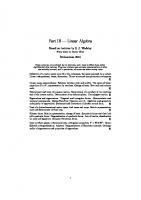
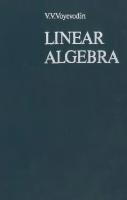
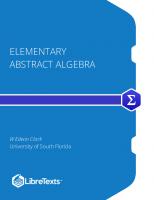
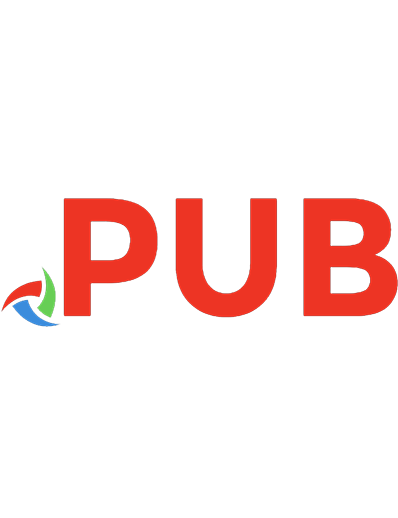
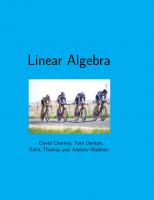
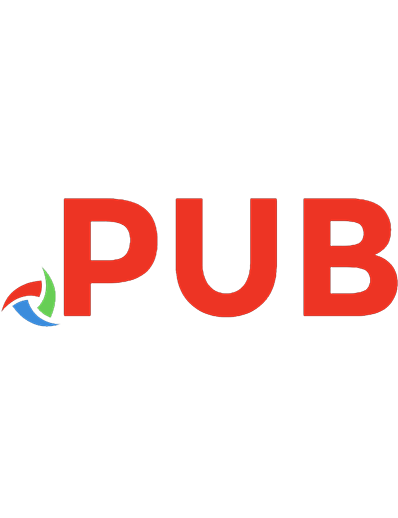
![Elementary Linear Algebra [5 ed.]
0471848190, 9780471848196](https://dokumen.pub/img/200x200/elementary-linear-algebra-5nbsped-0471848190-9780471848196.jpg)